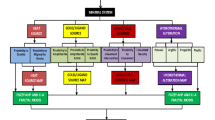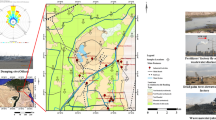Abstract
The alteration formed by the reaction of ore-bearing fluid and wall rock is often used as an important prospecting indicator, resulting in the dilution or enrichment of metals or related trace elements. A variety of rock-forming and metallogenic elements have been analyzed in regional stream sediments so that the relationship between the ore-bearing altered rock and the change in the geochemical elemental content can be obtained. Therefore, by using appropriate models, such as matched filtering, the abundance of the distribution of wall rock alteration, similar to the discovered deposits, can be modeled by using the distribution of geochemical elements in the region, and the areas with high distribution abundances are usually favorable prospecting targets. The alteration types related to gold mineralization in the Baiyun gold deposit are potassium feldspar alteration, silicification, pyritization, sericitization, and chloritization. In this paper, the geochemical data of the Qingchengzi ore field (1:200,000 and 1:50,000) have been used to form geochemical images through rasterization. In the three sections of the Baiyun gold deposit, binary-coded curves have been formed, revealing the differences in geochemical elements in stream sediments between altered rocks and the rocks surrounding the Baiyun gold mine. Among them, Au, W, and Mo are enriched elements, while Sn, Zn, and Hg are depleted elements. Several gold deposits are found in the predicted altered rock area by using the matched filtering method during fieldwork, which shows the effectiveness of the method.













Similar content being viewed by others
Data Availability
The datasets generated and/or analyzed during the current study are not publicly available due to interests related to mineral prospecting, but are available from the corresponding author upon reasonable request.
References
Rose AW, Hawkes HE, Webb JS (1979) Geochemistry in mineral exploration. Academic, San Diego, Calif
Solovov AP (1987) Geochemical prospecting for mineral deposits (Kuznetsov, V.V., Trans.), Engl. edn. Mir,Moscow, p 288
Beus AA, Grigorian SV (1977) Geochemical exploration methods for mineral deposits. Applied Publishing Ltd, USA, pp 31–270
Yilmaz H (2003) Geochemical exploration for gold in western Turkey: success and failure. J Geochem Explor 80(1):117–135
Yilmaz H, Oyman T, Arehart GB, Colakoglu AR, Billor Z (2007) Low-sulfidation type Au–Ag mineralization at Bergama, Izmir, Turkey. Ore Geol Rev 32(1-2):81–124
Plant J, Hale M (1994) Drainage geochemistry. In: Handbook of exploration geochemistry. Elsevier, Amsterdam
Hornbrook EHW, Garrett RG (1976) Regional geochemical lake sediment survey, east-central Saskatchewan. Geol Survey Canada 20:75–41
Ottesen RT, Bogen J, Bølviken B, Volden T (1989) Overbank sediment: a representative sample medium for geochemical mapping. J Geochem 32:257–277
Hosseini-Dinani H, Mokhtari AR, Shahrestani S et al (2019) Sampling density in regional exploration and environmental geochemical studies: a review. Nat Resour Res 28(3):967–994
McConnell J, Wand Davenport RH (1989) Gold and associated trace elements in Newfoundland lake sediment: their application to gold exploration. J Geochem Explor 32:33–50
Barthelemy F, Kassa Mombo M, Labbe JF (1987) Inventaire minier transgabonais: Campagnes geochimiques regionales et detaillees 1979-1986, Orleans,France, p 159
Chang CI (2003) Hyperspectral imaging: techniques for spectral detection and classification. Springer Science & Business Media
Zeegers H, Leduc C (1991) Geochemical exploration for gold in temperate, arid and semi-arid, and rain forest terrains. Blackie, Glasgow, pp 309–335
Harris DP (1965) An application of multivariate statistical analysis to mineral exploration. The Pennsylvania State University, p 261
Sinclair AJ, Woodsworth GJ (1970) Multiple regression as a method of estimating exploration potential in an area near Terrace, BC. Econ Geol 65(8):998–1003
Agterberg FP (1971) A probability index for detecting favourable geological environments. Canadian Institute Mining Metall 10:82–91
Singer DA (1972) Multivariate statistical analysis of the unit regional value ofmineral resources. Unpublished Ph.D. Dissertation, Pennsylvania State University, p 211
Zhang Q-S (1984) Geology and metallogeny of at Early Proterozoic in China. Jilin People's Press, Changchun, p 536
Xue C, Chen Y, Lu Y, Li H (2003) Metallogenic epochs of Au and Ag deposits in Qingchengzi ore-clustered area, eastern Liaoning Province. Mineral Deposits 22(2):177–184
Yu, G.,Chen, J.,Xue, C.,Chen, Y.,Chen, F.,Du,X(2009) Geochronological framework and Pb, Sr isotope geochemistry of the Qingchengzi Pb–Zn–Ag–Au ore field, Northeastern China. Ore Geol Rev 35(3-4):367-382
Zhang P et al (2019) Fluid inclusions, HO, S, Pb, and noble gas isotope studies of the Baiyun gold deposit in the Qingchengzi ore field. NE China. J Geochem Explor 200:37–53
Safronov NI (1936) Dispersion haloes of ore deposits and their use in exploration. Probl Sov Geol 4:41–53
Govett GJS, Atherden PR (1988) Applications of rock geochemistry to productive plutons and volcanic sequences. J Geochem Explor 30(1-3):223–242
Eilu P, Mikucki EJ (1998) Alteration and primary geochemical dispersion associated with the Bulletin lode-gold deposit, Wiluna, Western Australia. J Geochem Explor 63(2):73–103
McCuaig TC, Kerrich R (1998) P-T-t-deformation-fluid characteristics of lode gold deposits: evidence from alteration systematics. Ore Geol Rev 12(6):381–453
Pirajno F, Bagas L (2008) A review of Australia’s Proterozoic mineral systems and genetic models. Precambrian Res 166(1-4):54–80
Harris JR, Wilkinson L, Grunsky EC (2000) Effective use and interpretation of lithogeochemical data in regional mineral exploration programs: application of Geographic Information Systems (GIS) technology. Ore Geol Rev 16:107–143
Almeida CM, Olivo GR, Chouinard A, Weakly C, Poirier G (2010) Mineral paragenesis, alteration and geochemistry of the two types of gold ore and the host rocks from the Carlin-type deposits in the southern part of the Gold strike Property, northern Nevada: implications for sources of ore-forming elements, ore genesis, and mineral exploration. Econ Geol 105:971–1004
Zhang M, Li C, Fu P, Hu P, Ripley EM (2011) The Permian Huangshanxi Cu-Ni deposit in western China: intrusive-extrusive association, ore genesis, and exploration implications. Min Depos 46:153–217
Sanzhong L, Liu Y, Yang Z (2001) Continental dynamics and regional metamorphism of the Liaohe group. Geol Rev 47(1):9–18
Cheng Q, Hattori K, Fan J, Wang S (1994) Exploration history and geology of disseminated gold deposit at Maoling in proterozoic sedimentary rocks in North China platform. J Geochem Explor 51(1):93–108
Chen J, Yang G, Yu G, Du A, Qu W (2003) Re-Os dating of arsenopyrites from the Maoling gold deposit, northeast China. Geochim Cosmochim Acta 67(18):A59
Dejiang Y (2010) Characteristics and genesis of fine-clastic rock-type Au deposits in the Liaodong rift. Acta Geol Sinica 74(3):570–576
Ni P, Jiang S, Ling H (2003) Granite-related gold mineralization -fip study of Wulong gold deposit and Sanguliu granite, southern Liaoning province, ne China. Geochim Cosmochim Acta 67(18):334
Duan X, Zeng Q, Yang J, Liu J, Wang Y, Zhou L (2014) Geochronology, geochemistry and Hf isotope of late Triassic magmatic rocks of Qingchengzi district in Liaodong peninsula, Northeast China. J Asian Earth Sci 91(3):107–124
Liu J, Liu FX, Li SH, Lai CK (2019) Formation of the Baiyun gold deposit, Liaodong gold province, NE China: constraints from zircon U–Pb age, fluid inclusion, and C–H–O–Pb–He isotopes. Ore Geol Rev 104:686–706
Hao LB, Lu JL, Mo GS et al (2007) Method of using regional geochemical data in geological mapping in shallow overburden areas. Geol China 34(14):710
Xie X, Yan M, Wang C, Li L, Shen H (1989) Geochemical standard reference samples GSD 9-12, GSS 1-8 and GSR 1-6. Geostand Newsl 13(1):83–179
Xie X, Cheng H (1997) The suitability of floodplain sediment as a global sampling medium: evidence from China. J Geochem Explor 58(1):51–62
Gustavsson N, Lampio E, Tarvainen T (1997) Visualization of geochemical data on maps at the Geological Survey of Finland. J Geochem Explor 59(3):197–207
Keys R (1981) Cubic convolution interpolation for digital image processing. IEEE Trans Acoustics Speech Signal Process 29(6):1153–1160
Wiemker R (1996) Registration of airborne scanner imagery using Akima local quintic polynomial interpolation. In: In Presented at the Second International Airborne Remote Sensing Conference and Exhibition, vol 24, p 27
Akima H (1978) A method of bivariate interpolation and smooth surface fitting for irregularly distributed data points. ACM Trans Math Softw (TOMS) 4(2):148–159
Mazer AS, Martin M, Lee M, Solomon J (1988) Image processing software for imaging spectrometry analysis. Remote Sens Environ 24:201–210
Kwan C, Ayhan B, Chen G, Wang J, Ji B, Chang CI (2006) A novel approach for spectral unmixing, classification, and concentration estimation of chemical and biological agents. IEEE Trans Geosci Remote Sens 44(2):409–419
Harsanyi JC (1993) Detection and classification of subpixel spectral signatures in hyperspectral image sequences. University of Maryland, Baltimore County
Robey FC, Fuhrmann DR, Kelly EJ (1992) A CFAR adaptive matched filter detector. IEEE Trans. on Aerospace and Elect. Syst 28:208–216
Kraut S, Scharf LL (1999) The CFAR adaptive subspace detector is a scale invariant-invariant glrt. IEEE Trans Signal Process 47(9):2538–2541
Kwon H, Nasrabadi NM (2004) Hyperspectral target detection using kernel matched subspace detector. In: In 2004 International Conference on Image Processing, vol 4, pp 3327–3330
Deisy C, Subbulakshmi B, Baskar S, Ramaraj N (2007) Efficient dimensionality reduction approaches for feature selection. Int Conf Conf Comput Intell Multimedia Appl 2:121–127
Kozal AÖ, Teke M, Ilgın HA (2013) The effect of sub-sampling on hyperspectral dimension reduction. Nostradamus 2013: Prediction. Model Anal Complex Syst 1:529–537
Gourlay AR (1984) Grayscale simulation on a color display. Computer Vision Graphics Image Process 27(1):92–96
Chen J, Yousefi M, Zhao Y, Zhang C, Zhang S, Mao Z et al (2019) Modelling ore-forming processes through a cosine similarity measure: improved targeting of porphyry copper deposits in the Manzhouli belt, China. Ore Geol Rev 107:108–118
Guangyue G, Chenzhu J (1983) The origin of Baiyun gold deposit. Geol Explor 10:14–22
Gupta RP (2017) Remote sensing geology. Springer, Wiemker
Ai Y (1999) A discussion on some major problems of the Baiyun gold deposit, eastern Liaoning. Mineral Deposits (in Chinese with English abstract)
Funding
The research was jointly supported by the National Key Research and Development Plan (Grant Nos. 2016YFC0600108-09-01 and 2018YFC0603804) and the project of the “Geology of mineral resources in China” from the China Geological Survey (Grant Nos. DD20160346 and DD20190379).
Author information
Authors and Affiliations
Corresponding author
Ethics declarations
Conflict of Interest
The authors declare that they have no competing interests.
Additional information
Publisher’s Note
Springer Nature remains neutral with regard to jurisdictional claims in published maps and institutional affiliations.
Rights and permissions
Springer Nature or its licensor (e.g. a society or other partner) holds exclusive rights to this article under a publishing agreement with the author(s) or other rightsholder(s); author self-archiving of the accepted manuscript version of this article is solely governed by the terms of such publishing agreement and applicable law.
About this article
Cite this article
Chen, J., Yang, F., Bedini, E. et al. Application of the Matched Filtering Method to Study the Stream Sediment Geochemistry and Prospecting Prediction of the Baiyun Gold Deposit, Qingchengzi Ore Field, China. Mining, Metallurgy & Exploration 41, 379–394 (2024). https://doi.org/10.1007/s42461-023-00912-0
Received:
Accepted:
Published:
Issue Date:
DOI: https://doi.org/10.1007/s42461-023-00912-0




